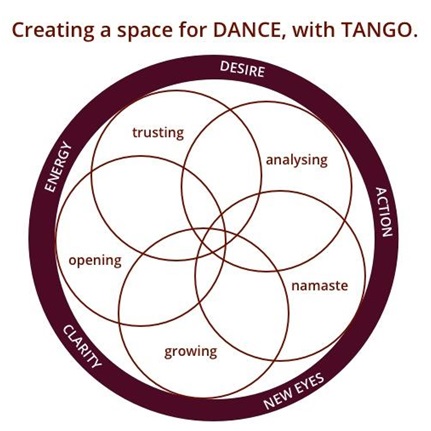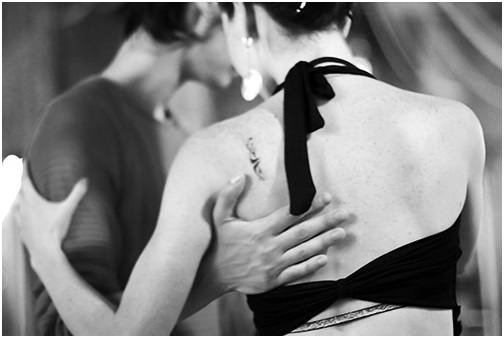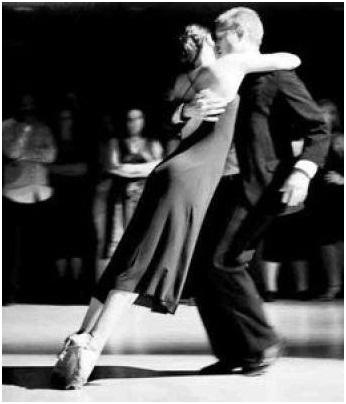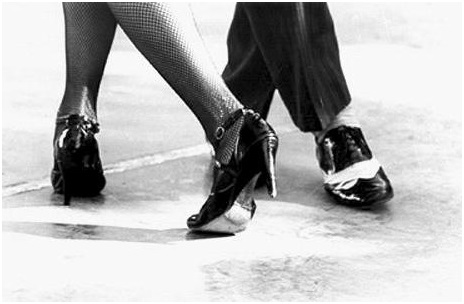A Coaching Model Created by Angela Ognev
(Transformational Coach, SINGAPORE)
Tango is the art of loving a stranger for two minutes.
My introduction to coaching was through the Co-Active model, where a cornerstone was about our dancing with the client. I knew then that coaching was something I wanted to explore deeply. As a dancer, the metaphor of dance is something that continues to add creativity and boldness to how I coach — it is the inspiration for trusting my instinct or using more movement and shifts of physical space.
This coaching model has two bits: DANCE (the space we want to create) and TANGO (how we create that space. Like a dance, this model is not a linear process, but one that builds directly onto that hour, that second. We’ll explore the metaphor further next section.
We want to create a space for DANCE: Desire, Action, New eyes, Clarity, Energy
We do this with TANGO: Trusting, Analyzing, Namaste, Growing, Opening
 As represented by the graphical model above, this model is not linear. It is fully about dancing in the moment — whereever that may take you, within the space created. The wider ring represents the space of DANCE, the energy and atmosphere built between the coach and the client. In it, you can take any of the connected paths, staying with one of the actions of TANGO, or switching quickly between many by following your deep listening and intuition.
As represented by the graphical model above, this model is not linear. It is fully about dancing in the moment — whereever that may take you, within the space created. The wider ring represents the space of DANCE, the energy and atmosphere built between the coach and the client. In it, you can take any of the connected paths, staying with one of the actions of TANGO, or switching quickly between many by following your deep listening and intuition.
To find the feeling of this dance, please explore these two videos. The first is a slow and engaged piece, while the second is more quirky and energetic. Each of these interactions and moods are similar to the space of a coaching session — a session may switch between the slow, thoughtful, and conscientious space of processing a heavy emotion, to creating action and lightness in another part of the session.
2 Videos
 Why dance a tango?
Why dance a tango?
What is the metaphor behind this coaching model? Dance as a metaphor is multi-dimensional. There are parts about learning the steps and practicing. Realising what came naturally and what felt was less natural. Noticing and being open to these realisations.
Dance is about channeling the energy of the music, the space, and your partner. Noticing where they are energised and building on it. Being confident in their confidence, and feeding their boldness with your own.
With a new partner, there is a willingness to adapt and flow together. A sensitivity to the sensitivity and quirks of the other. We often dance with our eyes closed to be more present with our partner. An immediate and silent forgiveness when there is a miscommunication, and a reaffirming of the abrase. Both and neither party is at fault, and both notices that that they would like to refocus. They start again with a really, really slow intentional step. They both want to reconnect. All this is communicate through intention, without words or gestures.
We learn about their history of dancing through their steps and the sway of their hips. We can sense it in the pressure they put with their fingertips on your shoulder. As we dance a few more minutes together, our styles become more in sync, and we complete complex, subtle actions without hesitate, inspiring awe. We create something together, both leading, both following.
We hesitate, we learn, and we celebrate as we grow. We forgive and adapt — better yet, we come in with that intention.
Dancing is something that resonates deeply with me — one summer at a tango festival, I danced each night until dawn for several days. Each day felt like a lifetime, filled with new close friends, evolving into new styles, understanding another person without speaking, and dancing with happiness on painful toes. The music was composed with meaning, as if they had captured the short essence of a human life within it.
Values
What are the values in this metaphor and model of dance?
There is a focus on the energy between two people — that both are leading and both are following at the same time, not just one or the other. The two, client and coach, come in with intention, every session. The client begins by leading, and where the client wants the coach to lead, the coach offers boldness to strength the client.
The two come in with an intention to creating something together. With that, there is a willingness for creativity, openness, boldness… and thus vulnerability. There is a lot of trust implied in this space because a dancer will not take risk where embarrassment is likely. They are willing to fall and step on toes when they feel comfortable dancing the way they’ve always wanted to dance.
The two adapt and forgive immediately, looking at ways to reconnect and focus and be present even more. Those “mistakes” become opportunities to create and learn about themselves and each other.
Coach and client are able to close their eyes (their main source of information for judgement), and trust in their other senses — listening to the music and their partner’s voice, noticing hesitate in the body, seeing the subtleties through new ways of observing. They simply notice and notice all there is to notice. They are curious to notice more, acknowledging and letting go of each noticing without judgement.
Dance. Improvise. There is no particular linear order, no choreography, though it feels more right to follow some steps with certain others, or some moves with certain music.
 Creating a Space for DANCE
Creating a Space for DANCE
We want to create a space for DANCE: Desire, Action, New eyes, Clarity, Energy
We do this with TANGO: Trusting, Analyzing, Namaste, Growing, Opening
The first part of this model is about creating a space — this is because it is easiest to check in with the energy we and our clients are feeling. It’s not something that we can measure very well, but it is something that we can know with certainty. It is something that our clients and comment on when they don’t feel the space the way they usually do. That is a another good place to bridge into a coaching conversation, another opportunity to notice. When things feel right, there are realisations, openness, growth, and action.
Desire
A space full of desire is one where a client is not afraid to dream. It is a space where anything is possible, and anything can be wanted. There are no limits and no judgements. The fear of success or of getting what we deserve takes a back seat. When we create a space for desire, the client can feel fully in themselves, fully alive. When we create a space for desire, a client can move beyond bullet action points or standardized goals — they can reach in and declare things they’ve been afraid to say.
They desire. They are trying to go somewhere, be something, accomplish something — that may change, shift, or be completely overthrown, but the forward energy is important to them. They have dreams, ones that they are even afraid to admit because declaring it is overwhelmingly scary. But they know it’s there, and they know it’s powerful. They are willing to want want they want, and acknowledge those desires. They’re here to get more clarity and channel their energy to achieve what their desires.
| Reflect: What’s something you’ve been afraid to declare because to do so means that you would have to make some big changes?What is something you want that energises and enlivens you? |
Action
A space full of action is one where a client can gain and build on momentum. It is full of steps, tiny and drastic, supported and risky, where a client can get where they’re going. It is not a space of reflection of theory, but one where all of that desire manifests itself outside of the coaching session. It is where dreams become realised.
It is when talk gives energy to the walk. It is also where things that are tried and failed are celebrated in their own way, and when plans change because the feelings have changed as well.
| Reflect: What’s something that you’ve always considered impossible?Imagine for a moment that it is possible. What’s next? What would be the last step, second last step, third last step, and so on? |
New eyes
A space that is full of new eyes one that uses new ways of knowing to understand things, and new perspectives to examine things. There are all kinds of angles and altitudes with which to understand and and then reframe a situation and many of them are here.
New eyes is also about using the senses that you wouldn’t normally use — less verbal communication and less sight. Consider how things sound or taste, think about how a goal feels rather than how it is described. Feel the weight of a situation literally or walk around the room or out the door in order to ask yourself the same question in a new space. Experiment.
| Reflect: What would you like a new perspective on? What’s something you can do that takes you away from your current time, place, emotional state, heart rate, etc and then reconsider that question? |
Clarity
A space that is full of clarity is one where words and feels are worthy — they get time and attention to be appreciated, unraveled, and digested. Clarity comes with lots of questions, and then lots of declarations and acknowledgements when that clarity is reached.
It is a space where certainty and confidence is felt, when a session can end and include bold decisiveness and comfort in one’s current place and time. We can feel good about clarity because it doesn’t pressure us to take more actions before we are ready.
| Reflect: What word, phrase, decision, or topic is vague? Give yourself another 5 minutes or another 90 to sit with it and see what happens. |
Energy
A space that is full of energy is one that has intention, and focus, but is also filled with supportiveness, authenticity, love, and even laughter or joy. When you leave the coaching conversation, both client and coached and more energised than they were when they were going in, no matter how emotionally “difficult” a topic might be considered.
| Reflect: Who or what energises you? How can you have a bit more of it? |
Doing the TANGO
We want to create a space for DANCE: Desire, Action, New eyes, Clarity, Energy
We do this with TANGO: Trusting, Analyzing, Namaste, Growing, Opening
To create the space illustrated in the first part of the model, we want to take five actions as a coach. Each of these actions are related to the coaching skills, and attributes. Questions on how to apply those skills are below.
Overall, the TANGO approach involves all of the coaching skills, but focuses primarily on powerful questions and listening, acknowledgment, and creating action and structure. Here’s an overview of the 5 actions:
Trusting – trust their resourcefulness, admit wandering attention and judgement
Analysing – synthesize and challenge, notice the details, name what you’re noticing
Namaste – open and close the session with intention, make disclaimers in the middle
Growing – develop and adapt to style, keep a growth mindset, grow with them
Opening – explore, dive deep on their agenda, see where they are excited and further it
Trusting
trust their resourcefulness, admit wandering attention and judgement
How do you TANGO? By trusting.
- Look for the genius in your client.
- Check yourself — when you notice worry, remind yourself that your client is creative, resourceful, and whole. They do not need to be fixed, nor are they hopeless without you. If you feel this way consistently, transfer to a new coach (or in some cases, a therapist.)
- Be open — if you weren’t listening for a second, let them know, and see if you can tie it back for a second. If you notice that you were being judgemental, notice it and see where it is coming from. Decide how you’ll like to move forward from there.
- Be with your instinct — if a powerful question comes to mind, or a challenge surprises you, try it out!
- When you demonstrate your trust, the relationship opens and deepens.
Trusting in action:
- “I’m very sorry. I noticed my attention wandering. Would you let me know why you’re sharing what you’ve said?”
- “Thank you for sharing that with me.”
- “I’m not sure where this is coming from, but an image of a traffic jam comes to mind. Does that expand on where you are right now somehow?”
- “I’m seeing you do this gesture again and again. What is that?”
Analysing
synthesize and challenge, notice the details, name what you’re noticing
How do you TANGO? By analysing.
- Try mirroring a client’s words back to them, or summarizing what you’ve heard and noticing the difference
- Use your words to describe what you’ve heard and acknowledge that it is your words
- Notice patterns between what the client has said and done in the past, or in stories about their past, and see if they would like to tie it into the conversation
- Look for the words that repeat and dig into them
- Look for the words and topics and energise
- Look for hesitation and name it
- Separate a statement of recounting of a story into multiple segments and see what their reflections are based on the segments
Analysing in action:
- “I’m noticing this phrase coming up in a few of our sessions — what is that?”
- “I’m hearing — and these are my own words — that you…”
- “It sounds like the question you want to ask has two parts. The first… the second… how does that sit with you?
- “There seems to be a lot of weight attached to the word/person/etc_______. Tell me more about that.”
 Namaste
Namaste
open and close the session with intention, make disclaimers in the middle
How do you TANGO? By using the principle of Namaste.
Namaste is about the respectful hello and goodbye of two people greeting each other. It illustrates the importance of marking the start or end in a significant way, because it it respects intention and time. It is also about acknowledging what is going on, by giving disclaimers where it makes sense.
- Start the session in a way that works for the two of you — I frequently start with 3 deep breaths, stretches, energising jumping jacks, an intention, or celebration, whether its in person or over the phone
- Have a tradition for the beginning — it’s usual to follow-up on the previous week, or give space for the client to start a new topic immediately if they’d like
- Close in a way that best transitions to the rest of their day. I like to end with a DO and a BE for the next week, as well as 3 deep breaths to add a space of pause to their day
- Acknowledge anything that is happening in the middle, such as when you are not listening, judging, when you notice yourself smiling or crying, or when you are using your own words, referring external material, or bringing back something from a past session
- Acknowledge scheduling or state-of-mind conflicts as early as possible, such as if you are cancelling due to dizziness, or having to end exactly one time to bring your attention to the next call
Namaste in action:
- “Would you like to start with three deep breaths?”
- “This is your space, and you get the last word. What would you like to add or reflect on before we close?”
- “I’m sorry for this last minute change, but I realise I can’t be fully present for our session, as I’ll be too in a rush. Instead, I’d like to offer…”
- “I notice that you have been late for our last three sessions. What is that? What can we do to both be fully present for our time together?”
Growing
develop and adapt to style, keep a growth mindset, grow with them
How do you TANGO? By growing.
- You learn to dance by reading, watching, and dancing more, and noticing what you’ve learned in those situations. Same thing with coaching. Keep making your education valuable, whether its through courses or experiences.
- Notice what makes your coaching unique and what people share with their friends. Build on that.
- Grow within the session by meeting the client where they are that day, time, and place, and adapting based on their agenda in that moment and in the longer run.
- Remember to cultivate your growth mindset. People have unlimited potential, rather than being a certain level of smart, resilient, etc.
- Notice your client’s growth over time and acknowledge it. Reflecting back on the past when we were in the details is incredibly rewarding.
Growing in action
- “I noticed that you answered my last question with a tone of voice I haven’t heard from you before. Could you tell me more about how you felt there, and how we can make even more of our time together?”
- “We’re halfway through the program so let’s both reflect and see how we’d like to move forward. What did you like about my coaching, and what was strange or uncomfortable for you?”
- “Could we look back on where we were with this topic two months ago? Here are a few quotes that I had written down from our sessions. What would you like to reflect on and celebrate here?
- “I notice that you’re more energetic now than you were 10 minutes ago at the beginning of the session. What is that?”
Opening
explore, dive deep on their agenda, see where they are excited and further it
How do you TANGO? By opening.
- Be curious. Look for where these is friction or energy, and dig deeper.
- You are not there to be their friend. Ask what no one else is bold enough or honest enough to ask. Hold the space for them.
- Ask them to expect the unexpected in your sessions.
- Watch out when you want to jump to problem-solving or taking action. That is a judgement that their topic is easy and obvious — instead, explore further, and looking for the underlying values, beliefs, and tangents. Notice what you find/
Opening in action
- “What would make this session a miracle for you?”
- “What do you want no one else to know?”
- “What if this is the weekend that changes everything.”
- “That is not a challenge – I know your challenge. What is actually a challenge, something that both scares you and excites you?”
- “Tell me more about that.”
- “What does _______ mean?”
Last notes
Create a space for dance. A space where a client can desire freely, without judgement, where they can act, notice with new eyes, have clarity and energy. Tango with them, by trusting and acknowledging, by analysing and mirroring, but starting and ending with namaste, but growing and opening together. Focus on your powerful listening and questions, your acknowledgements and ability to create action to create something beautiful together.
Reflection
- What in your life would you like to be more of dance? What would you like to dance more around?
- How do you feel about non-linear processes? How do you know where to go next?
- Think about a hobby you have? What about it makes you a good coach? What about being a good coach makes you a good hobbyist?